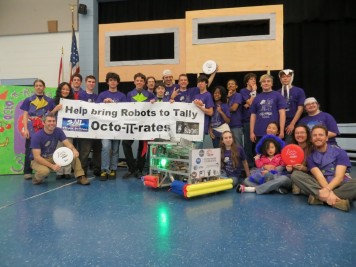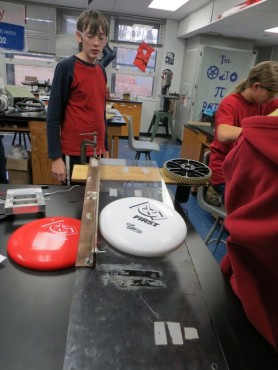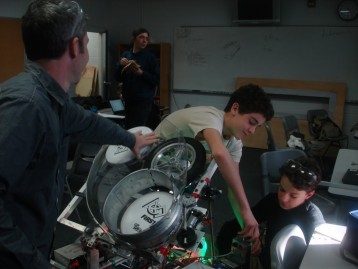Looking for a throwing partner with the consistency of a machine? Need to practice pulling down hucks, but don’t have a friend willing to play fetch for an hour? Help may be closer than we think. Enter the FIRST Robotics Competition (FRC). Referred to as “the varsity sport for the mind”, the FRC combines sport specific skills with the field of robotics for a unique competition where high school students to design, build, and control robots which compete with one another to complete a set of tasks. This year that task may be interesting to ultimate players: throwing a disc. While everyone has been worried about the professionalization of the sport, they really should be worried about being made obsolete by robots programmed to play some hybrid form of battlebot ultimate. Enter: Ultimate Ascent.
The video does a much better job explaining the specific rules of this year’s competition, but the long and short of it is that kids, along with their mentors, are designing robots to throw discs into specially designed goals, play defense, and even climb in order to score as many points as possible during a round.
 At SAIL, an arts and innovative learning high school in Tallahassee, Florida, the FIRST team, the Octo-Pi-Rates, is overseen by two ultimate enthusiasts, Jasun Burdick, a physics teacher, and his wife Wendy Chan. When the they found out that the challenge was ultimate related “everyone cheered and were hugging each other because our team has always had a passion for disc sports,” remembers Brenna Wolsey, the team’s junior captain.
At SAIL, an arts and innovative learning high school in Tallahassee, Florida, the FIRST team, the Octo-Pi-Rates, is overseen by two ultimate enthusiasts, Jasun Burdick, a physics teacher, and his wife Wendy Chan. When the they found out that the challenge was ultimate related “everyone cheered and were hugging each other because our team has always had a passion for disc sports,” remembers Brenna Wolsey, the team’s junior captain.
Burdick and Chan recruited some fellow players to help out, including Charles Robshaw, a special education teacher at SAIL and Jerris Hooker, a electrical engineer and post-doctoral associate at the National High Magnetic Field Laboratory. Not a bad ringer to have on your robotics team.
Burdick began the team in 2010 after receiving a $6500 grant from JC Penny. The fundraising aspect is a very important part of the competition, and FRC has strict guidelines for how a team can be funded. According to Chan, the students raise roughly $18,000 every year, which in itself is no small feat. However, the real challenge is getting an inanimate collection of wires and metal to throw a frisbee forty feet.
 Last year’s competition saw the team design a robot to shoot basketballs, and the experience has translated well to this year’s task. The team is using the same method to launch the discs. Chan explained “it’s a flywheel mechanism that was oriented vertically last year and now horizontally this year.” But minor modifications can lead to major headaches. She cautions that “the physics of the frisbee itself are indeed different and that we’ve had to adjust to. In our prototype we found that the discs sometimes come out in an ‘OI’ fashion when not launched appropriately.” The basketballs were much more easily controlled than discs. “They act completely different, they fly different, and they don’t really work well in our robot’s hopper. We had to do a lot more problem solving,” said the captain, Wolsey.
Last year’s competition saw the team design a robot to shoot basketballs, and the experience has translated well to this year’s task. The team is using the same method to launch the discs. Chan explained “it’s a flywheel mechanism that was oriented vertically last year and now horizontally this year.” But minor modifications can lead to major headaches. She cautions that “the physics of the frisbee itself are indeed different and that we’ve had to adjust to. In our prototype we found that the discs sometimes come out in an ‘OI’ fashion when not launched appropriately.” The basketballs were much more easily controlled than discs. “They act completely different, they fly different, and they don’t really work well in our robot’s hopper. We had to do a lot more problem solving,” said the captain, Wolsey.
Just getting to the point that your robot was throwing incorrectly might make minds of lesser intellects (your author included) swim, but in the end the team determined that all that needed to be done was place the launcher on the side in order to throw discs which would curve around the pyramid structures situated in the middle of the court. Duh!
While they are going for more traditional throws for the competition, Burdick insists that the possibility of getting fancy is real. “We are still not able to throw inverted discs yet. But after competition we hope to be able to rotate our thrower for any angle and a free style option with lots of Z’s.” A new youtube phenom on the horizon? Chan adds that “it would be pretty difficult to beat a robot at what it is designed to do.” Gauntlet down. Brodie Smith beware.
 Throwing, however, is not the only skill the team needs to teach the robot. It has to be able to withstand a fair bit of punishment from other robots, navigate the court with agility, and eventually climb one of the center pyramids to score serious points for the team. The robot can ‘strafe’, made possible by mecanum wheels and is being taught how to “see”, which requires a camera to track rectangular targets around the goals.
Throwing, however, is not the only skill the team needs to teach the robot. It has to be able to withstand a fair bit of punishment from other robots, navigate the court with agility, and eventually climb one of the center pyramids to score serious points for the team. The robot can ‘strafe’, made possible by mecanum wheels and is being taught how to “see”, which requires a camera to track rectangular targets around the goals.
No disc competition would be complete without the threat of major injury, and the pneumatic wheel, going at 3,000 RPM starts to melt pretty fast. “After four quick shots you can smell it,” says Burdick. What is the robot equivalent to Tommy John surgery?
We all know that defense wins championships, but the SAIL team is banking on a more Belichikovian strategy to bring home the hardware. The team’s philosophy is straightforward. “It’s simply more fun to score points,” says Chan. No argument there. The plan is to park the robot in the team’s “safe zone” and snap off 54 foot shots every two seconds. If anyone does try to play defense, they are hoping that their robot’s low center of gravity and agility will frustrate opponents.
Just to liven things up, at the end of the round, the human contestants get a chance to score more points for the team by throwing discs into goals. This is where the SAIL team, who will be wearing Skyd headbands for an added bit of luck, has a decided advantage. Charles Robshaw’s son is an 11th grader on the team, and he has been practicing his hammer during league for three seasons. Only a six foot wall and 56 feet stand between him and glory, and Robshaw is prepared to “flip out if he put one in the the last few seconds for a win!”








Comments Policy: At Skyd, we value all legitimate contributions to the discussion of ultimate. However, please ensure your input is respectful. Hateful, slanderous, or disrespectful comments will be deleted. For grammatical, factual, and typographic errors, instead of leaving a comment, please e-mail our editors directly at editors [at] skydmagazine.com.